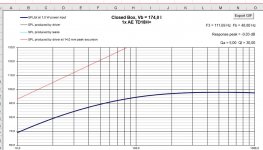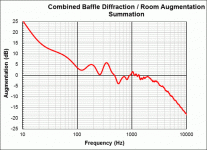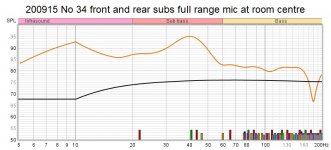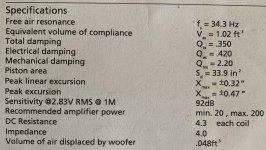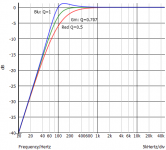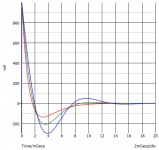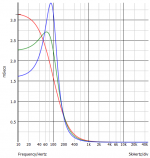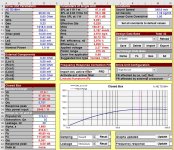Has anyone ever seen a sealed enclosure with an extremely low Q design, let say it has Q lesser than 0.5? Normally, Q of the sealed enclosure should be varied in 0.707 - 1.414 range, is it correct? Is it a good idea to make an extremely low Q in a sealed enclosure? Or is it simply a special design for correcting some special cases?
Last edited:
At one time it was common to use large woofers closed at 0.5-6 It has been said that holding low and going out slowly was a natural transition.
A higher Q at a higher frequency is clearly more abrupt, but it is the way to get the more important range covered when using a smaller driver sealed.
A higher Q at a higher frequency is clearly more abrupt, but it is the way to get the more important range covered when using a smaller driver sealed.
The extreme case is an open baffle, where Qtc = Qts of driver. You cannot have lower Qtc than the inherent driver's Qts.
The extreme case is an open baffle, where Qtc = Qts of driver. You cannot have lower Qtc than the inherent driver's Qts.
In aperiodic box, it is possible to have lower Qtc, than the original Qts of the driver.
Big sealed enclosure = infinite baffle
Reasonably big sealed enclosure works as an infinite baffle. This implies the enclosure doesn't reduce bass extension.
For example, 2x Eighteen Sound 21LW1400/8 (Qts 0.24) in 3000 liters enclosure working as subwoofers give us this:
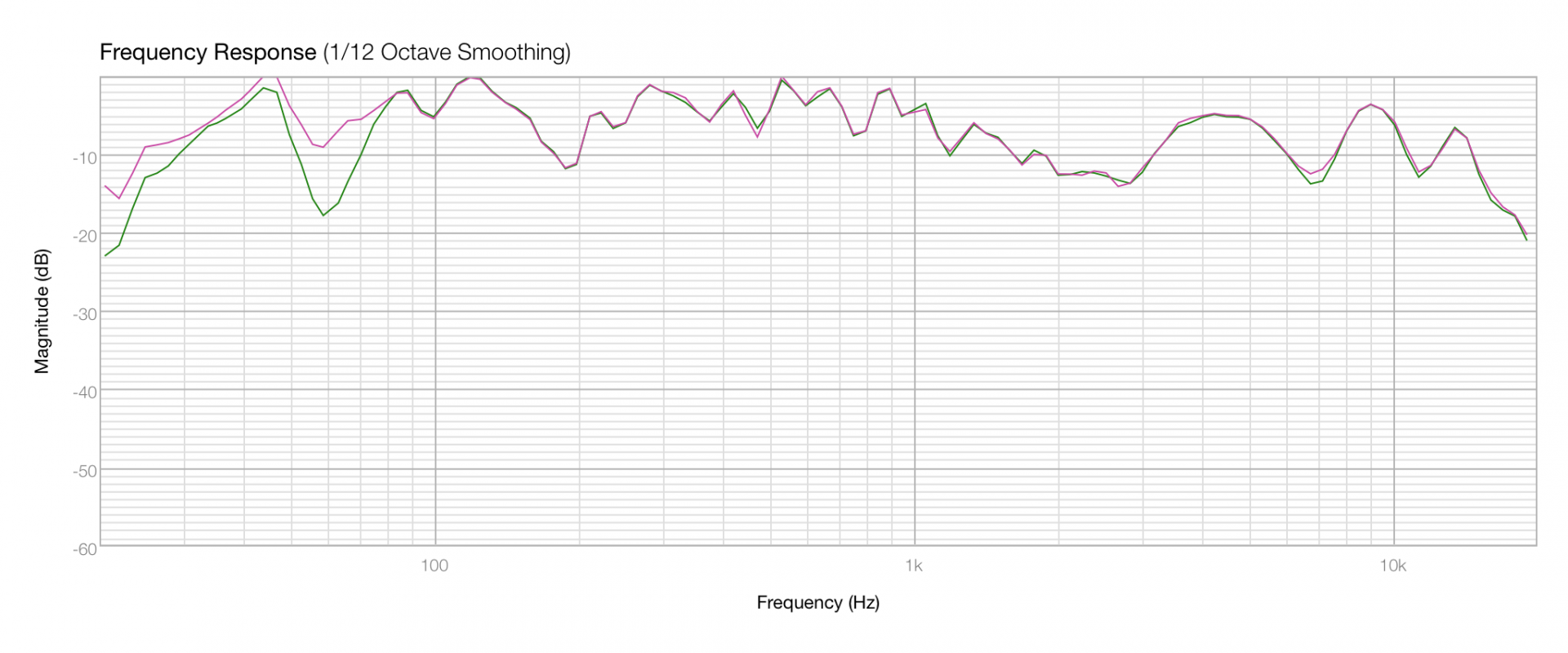
(green line shows speakers alone, violet with subwoofers). Seems as pretty decent bass extension to me.
Reasonably big sealed enclosure works as an infinite baffle. This implies the enclosure doesn't reduce bass extension.
For example, 2x Eighteen Sound 21LW1400/8 (Qts 0.24) in 3000 liters enclosure working as subwoofers give us this:
(green line shows speakers alone, violet with subwoofers). Seems as pretty decent bass extension to me.
Attachments
The owner manual of my woofers suggests using a wide range of Q; 0.34 - 0.65. I’m hesitating to choose one of these values. However, I’ve read that some hi-end speakers — sealed type — in 80s were popularly using extremely low Q. Help to share your opinion please.
Attachments
i have 0,25 measured by LIMP (0,16 qts factory) on 160L sealed. software says it´s 0,28 qtc
it has -11db high shelf to get it right
it has -11db high shelf to get it right
Last edited:
Theoretically my DIY sealed subs have a Qtc around 0,36, tuned to about 49 Hz, F3 as high as around 112 Hz. Reason for my choice: I wanted an even bass response and avoid a bloated bass, -as I have a concrete bunker which should give a lot of room and pressure gain.
The room and pressure gain makes up for quite a bit as can be seen i the REW-diagram compared with the driver simulation's SPL, with only less than 1 watt going out to front and rear subs ... The hump at around 40 Hz is due to 2nd length mode and can be EQ;ed down. Otherwise it is fairly smooth for un-Eq:ed subs. At 10 Hz the SPL is actually around 100 dB as my UMIK 1 show 7,4 dB too low value there (according to the calibration file). The amp gives up / has a filter below 10 Hz, otherwise the increase would continue below 10 Hz.
I think one should take into consideration the type of room one has. The room can be seen as a "special case" if one aims for an even bass with less problems to solve with various bass traps and treatment. Some info and program I used when I made my choice: Box-Q and Jeff Bagby's "Boundary Simulator": Loudspeaker Design Software (The diagram with the red curve)
(The subs are "more than enough", 4x18" at front + 4x15" at rear, but mostly for getting an even bass response.)
The room and pressure gain makes up for quite a bit as can be seen i the REW-diagram compared with the driver simulation's SPL, with only less than 1 watt going out to front and rear subs ... The hump at around 40 Hz is due to 2nd length mode and can be EQ;ed down. Otherwise it is fairly smooth for un-Eq:ed subs. At 10 Hz the SPL is actually around 100 dB as my UMIK 1 show 7,4 dB too low value there (according to the calibration file). The amp gives up / has a filter below 10 Hz, otherwise the increase would continue below 10 Hz.
I think one should take into consideration the type of room one has. The room can be seen as a "special case" if one aims for an even bass with less problems to solve with various bass traps and treatment. Some info and program I used when I made my choice: Box-Q and Jeff Bagby's "Boundary Simulator": Loudspeaker Design Software (The diagram with the red curve)
(The subs are "more than enough", 4x18" at front + 4x15" at rear, but mostly for getting an even bass response.)
Attachments
Last edited:
Normally, Q of the sealed enclosure should be varied in 0.707 - 1.414 range, is it correct?
Normally a sealed box is tuned to 0.5 to 0.707 optimally, a bit higher (up to say 0.9) can be tolerated if you want to compromise to get small box size.
As we move from Butterworth down the box size starts to grow quite dramatically so somewher between 0.58 & 0.707 is typically the target i go for. I have built some small woofers with Q approaching 0.5, i see no point in going lower, unless maybe the enclosure is the room next door. If lower than 0.5 EQ will probably be required.
dave
The owner manual of my woofers suggests using a wide range of Q; 0.34 - 0.65. I’m hesitating to choose one of these values. However, I’ve read that some hi-end speakers — sealed type — in 80s were popularly using extremely low Q. Help to share your opinion please.
What are the driver specs? I never pay much attention to other’s alignments since you don’t know what the design goals were.
dave
Here is the specs of the drivers. They are 8” drivers. The goal is to get a smooth bass. I like very smooth bass and dislike punch bass, a little boom is allowed since I have frequently used the bass boosting on tone controls. It’d be helpful if I hadn’t have to use it longer. My listening preferences: 60% pop music, 30% classical, 10% others (vocal, jazz, rock).
Attachments
Last edited:
Here is a standard set of sealed alignments for this unknown driver. You can use the 4 curves to estimate any box size in between key Q values. Lower Q boxes get alot bigger quickly. Keep in mind tht volume fill will increase the apparent volume of the box (say 10-20%).
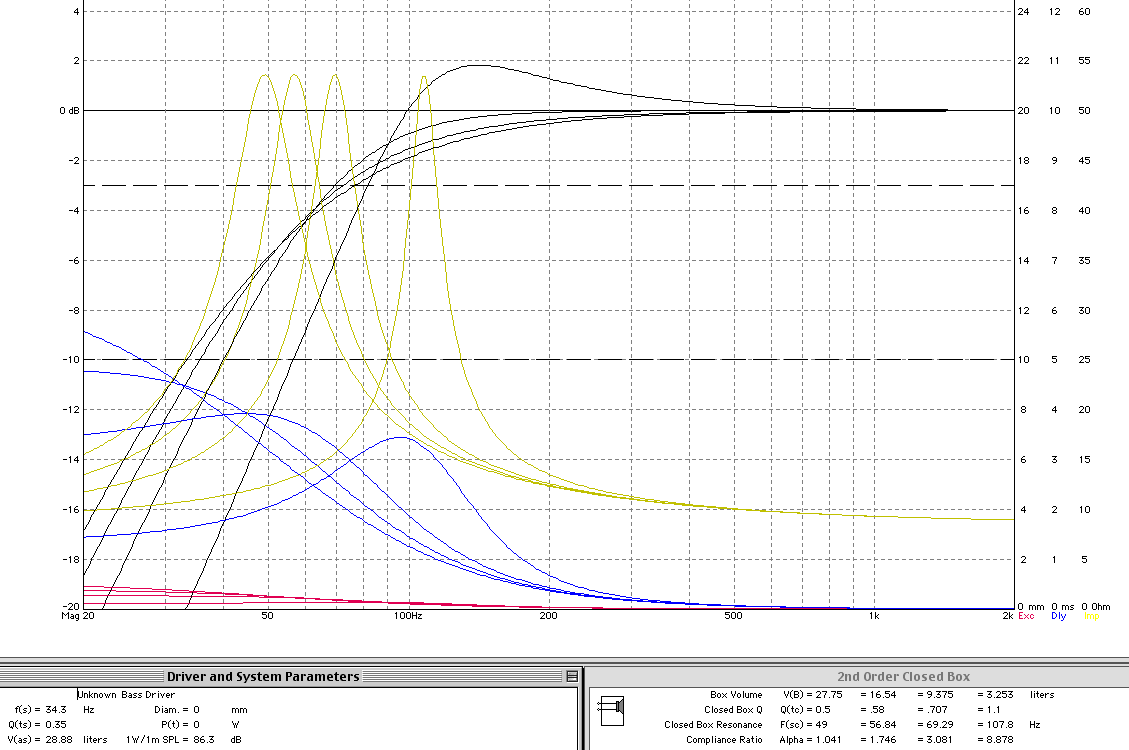
dave
dave
Attachments
I do it all the time, but mainly with midrange speakers, because the bass requires big enclosures.
The Q-factor can be compared to shock absorbers in a car.
Q=0.5 or less does not bounce back and forth after a step and higher Q increasingly does that.
The driver with high Q will constantly emit a wavelet of the resonance, additionally the response gets boomy, see the frequency plot.
Our ears are sensitive for this kind of thing, even 0.77 will sound a bit boomy and after some time listening fatigue will arise.
Q=1.414 certainly will sound crap, filters are needed, they can transform the Q to any desired value.
The group delay behaves gentle for Q=0.5, it reaches the maximum much below the f-3 where there is no output any more. Here the best would be a Bessel with Q=0.56
Filters can correct the Q, just a resistor in series can rise it, a lot of stuffing lowers the Q.
The Q-factor can be compared to shock absorbers in a car.
Q=0.5 or less does not bounce back and forth after a step and higher Q increasingly does that.
The driver with high Q will constantly emit a wavelet of the resonance, additionally the response gets boomy, see the frequency plot.
Our ears are sensitive for this kind of thing, even 0.77 will sound a bit boomy and after some time listening fatigue will arise.
Q=1.414 certainly will sound crap, filters are needed, they can transform the Q to any desired value.
The group delay behaves gentle for Q=0.5, it reaches the maximum much below the f-3 where there is no output any more. Here the best would be a Bessel with Q=0.56
Filters can correct the Q, just a resistor in series can rise it, a lot of stuffing lowers the Q.
Attachments
@presscot; how you describe your preference of bass response is much along my own thoughts before I built my subs. The various Qtc curves you get from a speaker simulation program is one thing. The bass response you end up with depends to a large degree on the type of room construction you have and where it is possible to place subs and listening position though. Check the diagrams in my above post Extremely low Q in sealed enclosure .
The downward slope I got from the Unibox-simulation has no resemblance at all to actual later measurements with REW which shows an upward slope towards lower freqencies. Simulation says about -28 dB down at 10 Hz from F3 at 112 Hz. Actual REW measurement show 80,2 dB at 112 Hz and +20,1 dB (!) at 10 Hz / 100,3 dB. The change of slopes is due to the room’s interaction and driver placement within the room versus reflective walls, floor and ceiling. In a sealed concrete room like mine the room interaction will be huge. A room construction with studs and drywall will show less of augmentation but probable room interaction should be considered if one wants to avoid troubles in the bass range. The links I posted can be helpful to study + a guesstimate before you decide on Qtc for the subs. If your room is very lossy, a higher Qtc than 0,707 could be a wiser choice.
(That I used several subs in the REWmeasurement isn’t that interesting. The interesting thing, in my view, is the change of slopes from a clearly downward one to an upward one, solely due to the type of room where the subs are placed. Enclosed is the Unibox-simulation.)
The downward slope I got from the Unibox-simulation has no resemblance at all to actual later measurements with REW which shows an upward slope towards lower freqencies. Simulation says about -28 dB down at 10 Hz from F3 at 112 Hz. Actual REW measurement show 80,2 dB at 112 Hz and +20,1 dB (!) at 10 Hz / 100,3 dB. The change of slopes is due to the room’s interaction and driver placement within the room versus reflective walls, floor and ceiling. In a sealed concrete room like mine the room interaction will be huge. A room construction with studs and drywall will show less of augmentation but probable room interaction should be considered if one wants to avoid troubles in the bass range. The links I posted can be helpful to study + a guesstimate before you decide on Qtc for the subs. If your room is very lossy, a higher Qtc than 0,707 could be a wiser choice.
(That I used several subs in the REWmeasurement isn’t that interesting. The interesting thing, in my view, is the change of slopes from a clearly downward one to an upward one, solely due to the type of room where the subs are placed. Enclosed is the Unibox-simulation.)
Attachments
Last edited:
Interesting on all comments. As posted on thread’s title, I’m now leaning towards the lower Q. And as recommended by the owner manual, Q = 0.34, which is the lowest value suggested, was going on in my mind. Still, there is a problem that I rarely see this extremely low Q used in any commercial speakers. The only commercial speaker I found using low Q was AR9 but that was only Q = 0.5.
Besides, I’ve found somewhere on the internet suggested that; with Q = 0.707 (Butterworth alignment), it is often regarded as ideal; Q = 0.577 (Bessel alignment), ideal response, but less low bass; Q = 0.5, suit for hi-end, but there’s almost no low bass!
In my case, I need a bass that is very smooth, and no punch. On the equaliser, I’ve experimented on bass adjustment, I found the bass range that satisfied me most was at 25Hz - 85Hz. Anything above 85Hz seemed to be much punching for me and below 25Hz seemed to be blur and useless. I’m, thereby, interesting in an extremely low Q (Q <= 0.5).
Has anybody ever seen or experienced with commercial speakers that have extremely low Q? How was their sound? Did they have almost no low bass?
Besides, I’ve found somewhere on the internet suggested that; with Q = 0.707 (Butterworth alignment), it is often regarded as ideal; Q = 0.577 (Bessel alignment), ideal response, but less low bass; Q = 0.5, suit for hi-end, but there’s almost no low bass!
In my case, I need a bass that is very smooth, and no punch. On the equaliser, I’ve experimented on bass adjustment, I found the bass range that satisfied me most was at 25Hz - 85Hz. Anything above 85Hz seemed to be much punching for me and below 25Hz seemed to be blur and useless. I’m, thereby, interesting in an extremely low Q (Q <= 0.5).
Has anybody ever seen or experienced with commercial speakers that have extremely low Q? How was their sound? Did they have almost no low bass?
Last edited:
- once had an Audio Concepts subwoofer box - two 11 inch Dynaudio woofers isobarik - low qtc - bottomed out very easily - limited xmax on those speakers - low qtc = not always a good thing to do.
Prescott, is it out of the question to build a couple of variants and listen for yourself? Way more informative than reading internet opinions if it's a possiblity.
True that, tsmith. Having heard something stays with you.
Another option is to use series resistance, or an amp with a higher output impedance. This increases the Q without changing the frequency, and in the case of the resistor comes at the expense of efficiency.
Indeed, although the Q wanted may change with frequency, and using a much smaller box raises that frequency.You can always raise the Q by adding something to the box, so it seems the risk is minimal.
Another option is to use series resistance, or an amp with a higher output impedance. This increases the Q without changing the frequency, and in the case of the resistor comes at the expense of efficiency.
- Home
- Loudspeakers
- Multi-Way
- Extremely low Q in sealed enclosure


